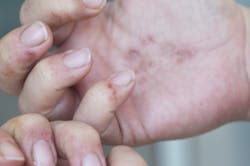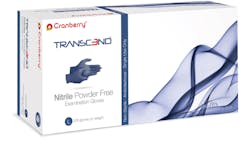Protect yourself and your patients by avoiding irritating glove ingredients
Over the last eight years, I came to expect dry, itchy, and red hands when working chairside. During the winter months, it was almost unbearable to don gloves without pain or compromising the integrity of the glove from the soothing lotion I had placed on my hands.
Powdered gloves only amplified my discomfort, while bulky gloves left me without the tactile sensitivity I needed to properly treat patients. While researching for a solution, I found that I was not alone in my pursuit of gloves that protected, while meeting the needs of my sensitive skin.
Skin dermatitis
Skin dermatitis, also known as “hand eczema,” can leave practitioners with red skin, itchiness, discomfort, and dry and cracked hands. (1) Studies report that “nearly 38% of hand eczema has been reported in health-care workers.” (2) Often treated with topical steroids, dermatitis can compromise the clinician’s comfort, especially while working.
Type IV hypersensitivity, also known as delayed hypersensitivity, is attributed to T-lymphocytes and T-cells, and often develops 48 to 72 hours after contact with an antigen. For hygienists who work in multiple locations that offer different brands of gloves, it may be difficult to know which brand is causing the problem. Not all skin types are the same; therefore, we have different needs in the gloves we select to use. Those affected by glove-induced skin contact dermatitis may take up to several months to experience total skin relief once the irritating ingredient is eliminated.
Chemicals such as dithiocarbamates, thiurams, and mercaptobenzothiazole, also known as “accelerators,” are common additives in gloves to help stabilize synthetic rubber molecules during the manufacturing process to increase elasticity and strength. However, the accelerators increase the risk of allergic reactions and often contain sulfurs that irritate the skin. (3)Manufacturers have begun to research new innovations to develop gloves without accelerators to decrease risk of allergic reactions.
A new clinical innovation
A new technology called Low Derma has eliminated the potential for Type I (latex allergy) and Type IV (delayed) hypersensitivity. Low Derma removes the use of chemical accelerators in the manufacturing of nitrile gloves. With this technology, nitrile gloves maintain high barrier integrity without the negative effects of sulfurs and other chemicals. (4)
Glove strength is not always directly related to the weight or feel of the glove. For example, Transcend gloves (Cranberry) demonstrate “a higher tensile strength at 37 megapascals (MPa), almost triple the minimum 14 MPa set by ASTM D6319 standards.” (5)Additionally, the gloves offer textured fingertips and 2.5 mm thickness that allow for increased tactile sensitivity.
When you are fulcruming on a molar while scaling a periodontal pocket that is bleeding heavily as you remove tenacious calculus, the last thing you’re thinking about is the integrity of the glove, and what it is made of. However, if the glove is poorly designed, it can compromise the safety of both the clinician and patient. Choosing a glove that protects both the clinician and patient from disease is critical. Use of gloves without irritating chemicals could protect your skin’s integrity.
References
1. Dibenedetti D, Baranowski E, Zelt S, Reynolds M, Sherrill B. Assessing United States patient and dermatologist experiences with severe chronic hand eczema. J Clin Aesthet Dermatol. 2015;8(11):19-27.
2. Ibler KS, Jemec GB, Flyvholm MA, Diepgen TL, Jensen A, Agner T. Hand eczema: prevalence and risk factors of hand eczema in a population of 2274 healthcare workers. Contact Dermatitis. 2012;67(4):200-207.
3. American Institute for Conservation of Historic and Artistic Works. Choosing gloves: a quick reference guide. AIC News. http://www.conservation-us.org/docs/default-source/periodicals/aic-news-vol-38-no-4-(july-2013).pdf?sfvrsn=8. Published July 2013. Accessed April 17, 2018.
4. The true meaning of protection. Low Derma website. http://www.lowderma.com/low-derma-identity.html. Accessed April 17, 2018.
5. Beyond protection. Cranberry website. https://www.cranberryglobal.com/beyond-protection/. Accessed April 17, 2018.
Editor's note: This article first appeared in RDH eVillage. Click here to subscribe.










